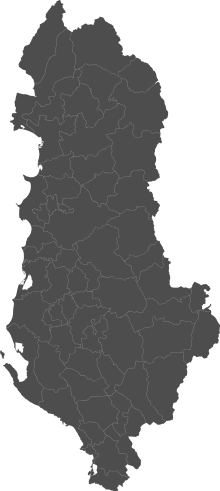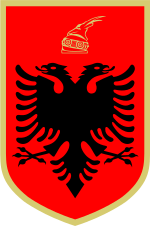Vlorë
Vlorë (/ˈvlɔːrə/ VLO-re,[2][3] Albanian: [ˈvlɔɾə] or [ˈvlɔɾa]) is the fifth most populous city of the Republic of Albania and the capital of the eponymous county and municipality.[1][4]
Vlorë | |
|---|---|
 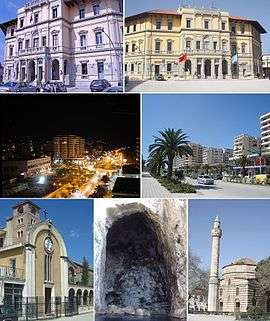 Vlorë | |
 Seal | |
 Vlorë  Vlorë | |
| Coordinates: 40°28′N 19°29′E | |
| Country | Albania |
| Region | Southern Albania |
| County | Vlorë |
| Settled | 6th century BC |
| Government | |
| • Mayor | Dritan Leli (Socialist Party) |
| Area | |
| • Total | 647.94 km2 (250.17 sq mi) |
| Elevation | 25 m (82 ft) |
| Population (2011) | |
| • Density | 212/km2 (550/sq mi) |
| • Municipality | 130,827[1] |
| Demonym(s) | Vlonjat (m) Vlonjate (f) |
| Time zone | UTC+1 (CET) |
| • Summer (DST) | UTC+2 (CEST) |
| Postal code | 9401–9405 |
| Area code(s) | 033 |
| Vehicle registration | VL |
| Website | Official Website |
Geographically, the city is located on the Bay of Vlorë and the foothills of the Ceraunian Mountains at the Strait of Otranto along the Adriatic and Ionian Sea within the Mediterranean Sea. Its climate is profoundly affected by the sea and therefore it experiences a Mediterranean climate with hot, dry summers and cool, wet winters.
Historically, the city was founded as Aulon as an Ancient Greek colony in Illyria and was centuries later conquered by the Romans, Byzantines, Normans, Venetians and Ottomans. Between the 18th and 19th centuries, the Albanian people gathered both spiritual and intellectual strength for national consciousness which conclusively led to the Albanian Renaissance. Thus, it was in the 20th century when the Albanian Declaration of Independence was proclaimed following the Assembly of Vlorë on the 28th of November 1912.
Culturally and economically, the city is one of the most significant cities of southern Albania and the region of Labëria which is traditionally popular for its traditions and folklore. It is served by the Port of Vlorë, the SH8 highway, and the A2 motorway representing a section of the Adriatic–Ionian Corridor as well as the Pan-European Corridor VIII.
Etymology
The modern name for the city in Albanian is Vlorë (indefinite form) and Vlora (definite form), pronounced as [ˈvlɔɾə] and [ˈvlɔra]. In Gheg Albanian it is known as Vlonë and Vlona, pronounced as [ˈvlɔnə] and [ˈvlɔna].[5] Vlorë was created in antiquity as a Greek colony in the territory of Illyria. Its first name was Aulón (Greek: Αυλών, also the name in modern Katharevousa), meaning "channel, glen" and possibly a translation of another indigenous name.[6] The medieval and modern Greek name is Avlonas (Αυλώνας Aulōnas [avˈlonas], accusative Αυλώνα Aulōna [avˈlona]), and is the source of the Latin Aulona, Italian name Valona (also used in other languages) and of the obsolete English Avlona.[7][8] During the Ottoman era the city of Vlorë was known in Turkish as Avlonya.[9]
History
Antiquity
Due to its strategic position on the Adriatic Sea, especially the Bay of Vlorë, which forms a natural harbor, Vlorë occupied a significant place in classical antiquity as a base for trade by many peoples. Vlorë is considered as one of the oldest cities in Albania and the region. The city was founded by the ancient Greeks in the 6th century BC and named Aulōn. It is also one of several colonies on the Illyrian coast,[lower-alpha 1] mentioned for the first time by Ptolemy (Geographia III xii, 2). In terms of Greek mythology the inhabitants of Aulon claimed descent from the Nostoi; returning heroes from Trojan War.[10] Other geographical documents, such as the Tabula Peutingeriana and Hierocles' Synecdemus, also mention Aulon. The city served as an important port of the Roman Empire, when it was part of Epirus Nova.[11][12]
Aulon (Avlona) became an episcopal see in the 5th century. Among the known bishops are Nazarius in 458 and Soter in 553 (Daniele Farlati, Illyricum sacrum, VII, 397–401). The diocese at that time belonged to the papal Pentarchy. In 733, it was annexed with the eastern Illyricum, to the Patriarchate of Constantinople, and yet it is not mentioned in any Notitiae Episcopatuum of that Church. The bishopric had probably been suppressed for though the Bulgarians had been in possession of this country for some time, Avlona is not mentioned in the "Notitiae episcopatuum" of the Bulgarian Patriarchate of Achrida.
During the Roman period, a Latin see was established and Eubel (Hierarchia catholica medii aevi, I, 124) mentions several of its bishops.[11]

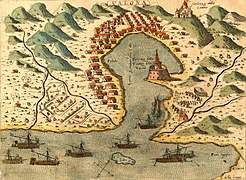
Aulon, no longer being a residential bishopric, is today listed by the Catholic Church as a titular see, a suffragan bishop of Durrës, being distinguished from a Greek titular see called Aulon by the use for it of the adjective Aulonitanus, while the adjective regarding the Aulon in Euboea (Ionian Greece) is Aulonensis.[13] The diocese was nominally restored as Latin titular bishopric Aulon, or Valona in Curiate Italian; from 1925 it was (als) named Aulona in Latin and/or Italian, since 1933 it's only Aulon in Latin, Aulona in Italian. It was a bishopric from the fifth century until Bulgarian rule.
Middle Ages
The city played a significant role in the conflicts during the 11th and 12th centuries between the Latin Norman Kingdom of Sicily, which established a Latin bishopric, and the Byzantine Empire.[8]
Ottoman control was established in Vlorë following its capture in 1417.[14] As part of the Ottoman Empire, Vlorë became a sanjak centre in Rumelia Eyalet under the name Avlonya. Later it become a Venetian possession in 1690 and the city was restored to the Ottomans in 1691, becoming a kaza of the Sanjak of Avlona in the vilayet (province) of Janina. At the time the city had about 10,000 inhabitants; there was a Catholic parish, which belonged to the Archdiocese of Durrës. During the early period of Ottoman rule, Vlorë became an international port centered on a high volume of trade between western Europe and the Ottoman state.[15]
In 1426, the Ottomans supported the settlement of a Jewish community involved in mercantile activities.[14] The community underwent population growth in subsequent decades with Jews migrating from Corfu, Venetian ruled lands, Naples, France, and the Iberian Peninsula.[14] Following their expulsion and arrival from Spain, the Ottoman state settled Jewish expellees in Vlorë toward the latter part of the fifteenth century.[14] Ottoman censuses for 1506 and 1520 recorded the Jewish population as consisting of 528 families and some 2,600 people in Vlorë.[14] The Jews of Vlorë were involved in trade and the city imported items from Europe and exported spices, leather, cotton fabrics, velvets, brocades, and mohair from the Ottoman cites of Istanbul and Bursa.[14] The Vlorë Jewish community took an active role in the welfare of other Jews such as managing to attain the release of war related captives present in Durrës in 1596.[14] After the Battle of Lepanto (1571) and the deterioration of security along the Ottoman controlled Adriatic and Ionian coasts, the numbers of Jews within Vlorë decreased.[14]
In 1851 it suffered severely from an earthquake.[8] The Jewish community of Yanina renewed the Jewish community of Vlorë in the nineteenth century.[14]
Independence of Albania
On November 28, 1912, Ismail Qemali declared the Albanian National Awakening in Vlorë, during the First Balkan War. The city became Albania's first capital following its independence, but was invaded by Italy in 1914, during the World War I. The city remained occupied by Italian forces until an Albanian rebellion forced the Italians out of Albania in 1920. Italy invaded Vlorë again in 1939. The city remained under Italian occupation until Italy surrendered to the allies in 1943. Subsequently, Nazi Germany occupied the city until 1944. The city was liberated in 1944 by communist forces under Enver Hoxha.

During the World War II, Sazan Island became the site of a German and Italian submarine base and naval installations; these installations were heavily bombed by the Allies.
After World War II, with Albania falling under communist rule, the port was leased out to the Soviet Union for use as a submarine base. During 1960 and 1961 it served as a theater in the aftermath of the fallout between Albanian dictator Enver Hoxha and Nikita Khrushchev. Albania denounced the USSR as 'revisionist' and took Chinese side in the Sino-Soviet split. In April 1961 the Soviet Union, resenting being pushed out after considerable investment in the naval facilities at nearby Pasha Liman Base threatened to occupy Vlora with Soviet troops, and cut off all Soviet economic, military and technical aid to Albania. The threat was not carried out, as a result of the simultaneous international developments, chief among them the Cuban missile crisis. Hoxha, realizing the vulnerability of Albania after the USSR invaded Czechoslovakia in 1968, ordered hundreds of thousands of concrete bunkers to be built, in a fit of paranoia. They still litter the Albanian landscape. Under Hoxha, Vlorë served an important recruiting centre for the Sigurimi, the Albanian secret police.
In 1997, Vlorë was the center of the Albanian civil war of 1997 after the collapse of several fraudulent investment schemes that led to the downfall of the Sali Berisha administration.
Geography
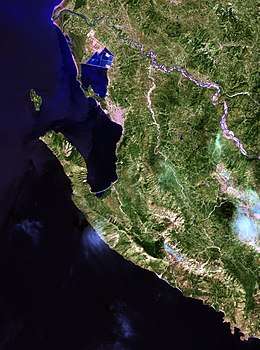
Topography
Vlorë is located in southern Albania and the administrative center of the homonymous municipality seat of Vlorë County. It is situated on the Bay of Vlorë, an inlet on the Adriatic Sea, almost surrounded by the Ceraunian Mountains. The Port of Vlorë is closer in proximity than any other to the port of Bari, Apulia in southeastern Italy, and is just 70 nautical miles (130 km) from Salento's coasts. Sazan Island is nearby, strategically located at the entrance to the Bay of Vlorë.
The town is surrounded by gardens and olive groves. Valonia oak (Quercus macrolepis), the mass name for acorn cups obtained in the neighboring oak forests and (because of its chemical derivatives) used by tanners, derives its name from Valona, the ancient name of Vlorë.
A motorway is being constructed linking the city with Fier and Albania as a whole. One of the most panoramic routes of the Albanian Riviera starts to the south of town stretching up to Sarandë in southernmost Albania.
Climate
Vlorë has a Mediterranean climate (Köppen: Csa) with cool wet winters and hot, dry summers with temperatures exceeding 30 °C (86 °F) in July and August. Vlore has a relatively high precipitation for the dry subtropical zone that is found, the values can be high in the end of the spring, but dry in the summit of the summer, although the other months may not be so low. The difference between the driest and wettest month can reach 184 mm. Usually the year is quite sunny except in the wettest months, being one of the sunniest places in the Eastern Mediterranean.[16][17][18]
| Climate data for Vlorë | |||||||||||||
|---|---|---|---|---|---|---|---|---|---|---|---|---|---|
| Month | Jan | Feb | Mar | Apr | May | Jun | Jul | Aug | Sep | Oct | Nov | Dec | Year |
| Average high °C (°F) | 13 (55) |
14 (57) |
16 (61) |
19 (66) |
23 (73) |
27 (81) |
30 (86) |
30 (86) |
27 (81) |
23 (73) |
19 (66) |
15 (59) |
21.3 (70.3) |
| Daily mean °C (°F) | 9.5 (49.1) |
10.0 (50.0) |
12.0 (53.6) |
15.0 (59.0) |
19.0 (66.2) |
22.0 (71.6) |
25.0 (77.0) |
24.5 (76.1) |
22.0 (71.6) |
19.0 (66.2) |
15.0 (59.0) |
11.5 (52.7) |
17.0 (62.6) |
| Average low °C (°F) | 6 (43) |
6 (43) |
8 (46) |
10 (50) |
14 (57) |
17 (63) |
19 (66) |
19 (66) |
16 (61) |
14 (57) |
11 (52) |
8 (46) |
12.3 (54.1) |
| Average precipitation mm (inches) | 120 (4.7) |
106 (4.2) |
92 (3.6) |
79 (3.1) |
54 (2.1) |
28 (1.1) |
9 (0.4) |
26 (1.0) |
32 (1.3) |
116 (4.6) |
192 (7.6) |
141 (5.6) |
995 (39.2) |
| Average precipitation days (≥ 0.1 mm) | 13 | 12 | 14 | 11 | 9 | 6 | 3 | 3 | 5 | 10 | 17 | 17 | 120 |
| Mean monthly sunshine hours | 133.3 | 147.9 | 173.6 | 225.0 | 272.8 | 318.0 | 368.9 | 344.1 | 279.0 | 210.8 | 117.0 | 99.2 | 2,689.6 |
| Source: climatetemp.info[17] | |||||||||||||
| Climate data for Vlorë, elevation: 44 m or 144 ft, 1961-1990 normals and extremes[lower-alpha 2] | |||||||||||||
|---|---|---|---|---|---|---|---|---|---|---|---|---|---|
| Month | Jan | Feb | Mar | Apr | May | Jun | Jul | Aug | Sep | Oct | Nov | Dec | Year |
| Record high °C (°F) | 23.6 (74.5) |
29.6 (85.3) |
28.2 (82.8) |
29.6 (85.3) |
37.2 (99.0) |
41.0 (105.8) |
41.6 (106.9) |
38.0 (100.4) |
38.0 (100.4) |
31.8 (89.2) |
28.5 (83.3) |
24.5 (76.1) |
41.6 (106.9) |
| Average high °C (°F) | 13.2 (55.8) |
13.9 (57.0) |
15.9 (60.6) |
19.0 (66.2) |
23.2 (73.8) |
27.0 (80.6) |
29.7 (85.5) |
29.8 (85.6) |
27.0 (80.6) |
22.8 (73.0) |
18.2 (64.8) |
14.5 (58.1) |
21.2 (70.1) |
| Average low °C (°F) | 4.8 (40.6) |
5.3 (41.5) |
6.6 (43.9) |
9.6 (49.3) |
13.2 (55.8) |
16.6 (61.9) |
18.4 (65.1) |
18.3 (64.9) |
15.9 (60.6) |
12.5 (54.5) |
9.5 (49.1) |
6.3 (43.3) |
11.4 (52.5) |
| Record low °C (°F) | −7.0 (19.4) |
−4.8 (23.4) |
−6.3 (20.7) |
−0.5 (31.1) |
4.6 (40.3) |
10.1 (50.2) |
11.4 (52.5) |
12.2 (54.0) |
6.6 (43.9) |
3.0 (37.4) |
−0.6 (30.9) |
−3.5 (25.7) |
−7.0 (19.4) |
| Average precipitation mm (inches) | — | — | — | — | — | — | — | — | — | — | — | — | 879.6 (34.63) |
| Average rainy days (≥ 1.0 mm) | — | — | — | — | — | — | — | — | — | — | — | — | 82.0 |
| Average snowy days | — | — | — | — | — | — | — | — | — | — | — | — | 1.0 |
| Average relative humidity (%) | — | — | — | — | — | — | — | — | — | — | — | — | 66.0 |
| Mean monthly sunshine hours | — | — | — | — | — | — | — | — | — | — | — | — | 2,745.2 |
| Source: NOAA[19] | |||||||||||||
Demographics
The present municipality was formed by 2015 local government reform, which merged these former municipalities: Novoselë, Orikum, Qendër Vlorë, Shushicë, and Vlorë; they became municipal units. The seat of the municipality is Vlorë.[20] The total population is 104,827 (2011 census),[21] in a total area of 647.94 km2 (250.17 sq mi).[4] The population of the former municipality at the 2011 census was 79,621.[21] The new municipality extends from the Vjosë river delta near Novoselë up to Llogara Pass including the town of Orikum.
Religion
In Albania, a secular state with no state religion, the freedom of belief, conscience, and religion is explicitly guaranteed in the constitution of Albania.[23][24] Vlorë is religiously diverse and possesses many places of worship catering to its religious population, who are traditionally adherents of Islam, Christianity, and Judaism.
During the 19th and early 20th century, Albanian-speaking Muslims were the majority population of Vlorë while there was a small number of Greek-speaking families, Albanian Orthodox, Jews, and an even smaller number of Catholics.[25] In 1994 the ethnic Greek community of the city numbered 8,000 people.[26] A Greek school was operating in the city in 1741.[27]
According to the 2011 census, Islam is the biggest religion in Vlorë with 43.3% of the inhabitants identifying as Muslims and 0.8% as Bektashis. Christianity is the second largest religion of Vlorë and is divided between the Eastern Orthodox who were 9.1% and Roman Catholic Church who were 1.4%. The census did not include specific municipality level data for other groups, but the data for the county of Vlorë (which includes also other municipalities) showed it had the second highest percentage of atheists in Albania, with the first being the county of Gjirokastër (6.01% compared to 6.3%).[28]
Economy

The city of Vlorë remains a major seaport and commercial centre, with a significant fishing and industrial sector. The surrounding region produces petroleum, natural gas, bitumen and salt. The city is also the location of important installations of the Albanian Navy. It has grown in importance as an agricultural center with very large-scale planting of olive and fruit trees, and as a center of the food processing, oil, and bitumen export industries. Historically, the surrounding district was mainly agricultural and pastoral, producing oats, maize, cotton, olive oil, cattle, sheep, skins, hides, and butter.[8] These commodities are exported.
Vlorë is a vibrant coastal city with a well-developed and modern housing infrastructure. The city offers a variety of residential areas ranging from the coast and going inland. Vlorë is divided into three economic zones.[29] The Free Economic Zone TEDA Vlorë has a strategic location, some 151 kilometres (94 miles) away from the capital Tirana. The A2 is part of Pan-European Corridor VIII and adjacent to the Adriatic Ionian Motorway, including a direct exchange with the National Road 8, 4.6 kilometres (2.9 miles) away. The Tirana International Airport is 147 kilometres (91 miles) away from the city and is suitable for transportation of cargo and passengers. There is an existing railway infrastructure passing through the area. Vlorë has access to the Port of Durrës

(120 kilometres (75 miles)) and the Port of Vlorë (5.7 metres (18.7 feet)), the two largest ports in Albania. The Land and Environmental Information is located in a flat, saline land, partially covered by Soda Forest. The area is suitable for industrial and environmentally friendly development. The Industrial development inside the zone eligible activities that can be developed in TEDA are: industrial, processing, commercial, goods storage, light industry, electronics, auto parts manufacturing, and port related activities. The Labor market: Official data from 2014 reported the employable labor force in Vlora at 125,954, of which 84,836 are currently employed. 35% of the labor force in Vlora has a high school degree, while 17% has a university degree. Vlora boasts the second largest university in Albania, Ismail Qemali and several vocational education schools.
According to the World Bank, Vlorë has made significant steps in the economy rankings in 2016. Vlorë ranks 7th among 22 cities in Southeastern Europe in rankings conducted by the World Bank Group. [30] ahead of the capital of Albania, Tirana, and also Belgrade, Serbia and Sarajevo, in Bosnia and Herzegovina.
Transport
The A2 motorway is a four-lane motorway stretching between Fier and Vlorë along the Adriatic sea coast of Albania. On 3 February 2015, the Albanian Government received the full amount of the funding for the Vlorë Bypass 29 kilometres (18 miles) long linking A2 with coastal SH8 along the Albanian Riviera. It is expected to start around mid/late 2015 and be completed in 2016 or early 2017.[31]
Vlorë Bypass consists of a 29-kilometre (18-mile) long route composed of a new single carriageway highway, numerous new bridges, and eight at-grade junctions. The project starts from the Roundabout at the end of the Double Carriageway Levan Vlora.[32]
The Ministry of Transportation has announced the construction of Vlorë International Airport. The project includes the construction of a marina and agri-tourism site and is expected to finish by 2023.[33] The new airport is expected to have a major impact on economic growth and tourism.[34] It will be the third largest airport in Albania after Tirana International Airport and Kukes International Airport.
The city is served by Vlorë Railway Station, though the rail service is now very limited.
The Port of Vlorë is the second largest in the country. Vlorë comprises a dry cargo port, the Vlorë 1 petroleum port and a fishing harbour. The Port is conceived as part of the Lungomare Project, stretching from the harbor to the Forest of Sodë. Part of this project is the construction of a yacht port, while the new Trans-Balkan road, which has been completed, will be added a second segment that starts from the existing road to the port.[35] The rehabilitation of the port, expected to end by the end of 2016, includes the construction of the area for freight, and a passenger terminal. Vlora will have for the first time a modern port for both freight and passengers, to become a catalyst of the economic and tourist development of Albania.
Culture
In Vlorë there are three functioning museums: the Independence Museum, the Historic Museum and the Ethnographic Museum of Vlorë.[36] Each museum discovers different characteristics of the Vloran history. Vlora host also the Shevqet Musaraj Library. Vlorë is home to different architectural styles that represent influential periods in its history. The architecture is influenced by Illyrian, Greek, Roman, Italian and Communist architecture. In the 21st century, Vlorë has turned into a modern city, with modern new buildings and many green spaces. The Lungomare Vlora Waterfront Project is currently under construction.
Sights
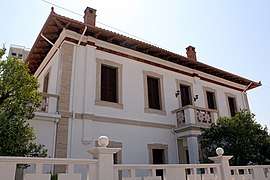
- Karaburun Peninsula is located in the Southern of Albania where the Adriatic Sea meets the Ionian Sea.
- Flag's Square is the main plaza in Vlorë, dedicated to the Albanian Declaration of Independence.
- Independence Monument is found in the Flag's Square.
- Kaninë Castle was built on the site of an ancient settlement, one of the oldest in the Vlora region.
- Marmiroi Church is mentioned in historical records for the first time in 1307. It is thought to have been built in the 12th or 13th century.
- Muradie Mosque was built in 1537 by the Ottoman Turkish architect Mimar Sinan during the rulership of Suleiman the Magnificent.
- Oricum was an ancient city at the south end of the Bay of Vlorë. The city is an Archaeological Park of Albania.
- Sazan Island it is strategically located between the Strait of Otranto and the entrance to the Bay of Vlorë. More than half of the island's surrounding marine area forms part of the Karaburun-Sazan National Marine Park.
- Zvërnec Island is nearly all covered with tall pine trees and is just east of a much smaller island. It contains the well preserved 13th-14th century Byzantine Zvërnec Monastery.
- Narta Lagoon is the second largest lagoon in Albania.
Tourism

Tourism has become a major industry in recent years, with many hotels, recreational centers, and vast beaches. The city has a good view over the Bay of Vlorë, which is considered the frontier between the Adriatic Sea and the Ionian Sea. The Island of Sazan is close by, at the entrance to the bay. Italy is just 80 kilometres (50 miles) away. With 300 sunny days per year Vlorë is a good location to stay for business or vacations. Some nearby beaches include Palasë, Dhermi, Vuno, Himara, Qeparo, and Borsh. The bay offers good conditions for navigation at sea and anchorage of ships. Other attractions include food, wine, mountains, and sports.
Education
Vlora is home to the second largest university in Albania. The University of Vlora Ismail Qemali University was created in 1994 as a Technological University. It started with a few hundred students and today is the second biggest university in Albania with nearly 15,000 students. It retains a focus on technology, but has expanded in the areas of economics and finance, education, medicine, and law. UV is the leading research university in Albania. It is the most productive university in Albania in organizing research conferences, inviting researchers from leading institutions, and sending its own researchers abroad. Some of the more important areas of research are mathematics, computer science, and engineering. It has also active groups in Albanian literature, economics and finance, folk music and dance, education, etc. The Vlora Conference Center is a leader in organizing conferences in Albania and has organized conferences yearly at the University of Vlora. Its board is composed of internationally known scientists.
There are three internationally known journals based in the University of Vlora. They are the highest quality journals of any Albanian speaking university. Albanian Journal of Mathematics, Albanian Journal of Mechanical Engineering. There is also a scientific journal published quarterly in Albanian: Buletini Shkencor i Universitetit te Vlorës. Since 2008 it is home to the Academicus International Scientific Journal, a peer-reviewed scientific publication in the English language founded by Arta Musaraj.[37] Many summer schools and training sessions are organized at the University. Vlora is a tourist destination, and this makes it very attractive for organizing international conferences.
In addition, University of Vlora has programs in naval engineering and navigation. Studying the Bay of Vlora has been one of the main projects of the navigation department in the last few years. The Bay of Vlora is an important place in world history with important events such as Caesar's battles, medieval times, World War I, and World War II, etc. In the bay is one of the oldest military naval bases in the world which continues to be used to this day. The Naval Base of Pashaliman was the only Russian base in the Mediterranean in the 1950s, and was the hot spot of conflict between the Russians and the Albanians in 1961 when Albania pulled out of the Warsaw Treaty. The Department of Navigation is mapping all the ships sunk in the bay area, and is doing research in the area of marine archeology in the ancient town of Orikum (Oricum).
Researchers from UV participate in congresses and conferences all over the world. UV has joint projects and exchange programs with some of the best universities in the world and very actively is trying to expand further such programs.
Besides the state university there are two private universities: Universiteti Pavarësia Vlorë, established in 2009; and Akademia e Studimeve të Aplikuara "Reald", which started as primary school and high school, and since 2011 operates also as a university.[38]
Sports
The citizens of Vlorë enjoy many kinds of sports. The most popular is football. Vlorë has two professional teams: KS Flamurtari Vlorë and Vlora City FC. Flamurtari currently plays in the Albanian Superliga, while Vlora FC competes in the Albanian First Division.
Other sports played in Vlorë include basketball, volleyball, handball, athletics, and swimming.
Popular culture
Vlorë appears in the video game Tom Clancy's EndWar as a possible battlefield. In the game, a major oil refinery is located there, which receives oil from the Black Sea.[39]
Notable people
Notes
- "town that is the second seaport of Albania. It was strategically important during the Roman period and in the 11th to the 12th-century wars between Normans and the Byzantine Empire" (EB editors 2016).
- Monthly data only for temperatures
References
- Ines Nurja (2013). "Censusi i popullsisë dhe banesave / Population and Housing Census – Vlorë 2011" (PDF). instat.gov.al (in English and Albanian). Tirana. p. 84.
- "Vlorë". Lexico UK Dictionary. Oxford University Press. Retrieved 5 July 2020.
- "Vlorë". The American Heritage Dictionary of the English Language (5th ed.). Boston: Houghton Mifflin Harcourt. Retrieved 5 July 2020.
- "Correspondence table LAU – NUTS 2016, EU-28 and EFTA / available Candidate Countries" (XLS). Eurostat. Retrieved 2019-09-25.
- The New Encyclopædia Britannica. Encyclopædia Britannica. 1974. p. 479. ISBN 0-85229-290-2.
- Room, Adrian (2006). Placenames of the World: Origins and Meanings of the Names for 6,600 Countries, Cities, Territories, Natural Features, and Historic Sites. McFarland, Incorporated. p. 398. ISBN 978-0-7864-2248-7.
- "

- Chisholm 1911.
- Gawrych, G. W. (2006). The crescent and the eagle: Ottoman rule, Islam and the Albanians, 1874-1913. I.B.Tauris. p. 23. ISBN 978-1-84511-287-5. Google Book Search. Retrieved on August 25, 2009.
- John Papadopoulos (2016). Molloy, Barry (ed.). Of Odysseys and Oddities: Scales and Modes of Interaction Between Prehistoric Aegean Societies and their Neighbours. Oxbow Books. p. 382. ISBN 1785702343.
Aulon... claiming descent from the heros of the Nostoi, the legend of those returning from Troy.)
- Vailhé 1912.
- "Apollonia and Aulon in Epirus Nova" (Bowden 2003, p. 14)
- Annuario Pontificio 2013 (Libreria Editrice Vaticana 2013 ISBN 978-88-209-9070-1), p. 842
- Giakoumis, Konstantinos (2010). "The Orthodox Church in Albania Under the Ottoman Rule 15th-19th Century". In Schmitt, Oliver Jens (ed.). Religion und Kultur im albanischsprachigen Südosteuropa [Religion and culture in Albanian-speaking southeastern Europe]. Frankfurt am Main: Peter Lang. pp. 95–96. ISBN 9783631602959.CS1 maint: ref=harv (link)
- Stanford J. Shaw; Ezel Kural Shaw (29 October 1976). History of the Ottoman Empire and Modern Turkey: Volume 1, Empire of the Gazis: The Rise and Decline of the Ottoman Empire 1280-1808. Cambridge University Press. p. 69. ISBN 978-0-521-29163-7.
- Polemio, M.; CNR-IRPI Pambuku, A.; Servizio Geologico di Albania Petrucci, O.; CNR-IRPI. The coastal karstic aquifer of Vlora (Albania). OCLC 697554091.CS1 maint: multiple names: authors list (link)
- "Vlorë Weather Averages". August 2011. Archived from the original on 2010-08-21.
- Begaj, Majlinda. "Vlora guida". Cite journal requires
|journal=(help) - "Vlorë (13600) - WMO Weather Station". NOAA. Retrieved May 12, 2019.
- Law nr. 115/2014 Archived 2015-09-24 at the Wayback Machine
- "Population and housing census - Vlorë 2011" (PDF). INSTAT. Retrieved 2019-09-25.
- "Religion in Vlorë Municipality 2011". /www.instatgis.gov.al.
- "Constitution of the Republic of Albania" (PDF). osce.org. OSCE. p. 2.
- "ALBANIA 2016 INTERNATIONAL RELIGIOUS FREEDOM REPORT" (PDF). state.gov. pp. 1–7. Archived from the original (PDF) on 2017-08-15.
- Kokolakis, Mihalis (2003). Το ύστερο Γιαννιώτικο Πασαλίκι: χώρος, διοίκηση και πληθυσμός στην τουρκοκρατούμενη Ηπειρο (1820–1913) [The late Pashalik of Ioannina: Space, administration and population in Ottoman ruled Epirus (1820–1913). EIE-ΚΝΕ. p.52. "β. Ο διεσπαρμένος ελληνόφωνος πληθυσμός περιλάμβανε... και μικρό αριθμό οικογενειών στα αστικά κέντρα του Αργυροκάστρου και της Αυλώνας. [b. The scattered Greek-speaking population included ... and a small number of families in the cities of Gjirokastra and Vlora.]"; p. 53. "και την ακόμη ολιγομελέστερη ομάδα των Καθολικών της Αυλώνας [and even group of Catholics in Vlora]"; p. 54. "Η μουσουλμανική κοινότητα της Ηπείρου, με εξαίρεση τους μικρούς αστικούς πληθυσμούς των νότιων ελληνόφωνων περιοχών, τους οποίους προαναφέραμε, και τις δύο με τρεις χιλιάδες διεσπαρμένους «Τουρκόγυφτους», απαρτιζόταν ολοκληρωτικά από αλβανόφωνους, και στα τέλη της Τουρκοκρατίας κάλυπτε τα ¾ περίπου του πληθυσμού των αλβανόφωνων περιοχών και περισσότερο από το 40% του συνόλου. [The Muslim community in Epirus, with the exception of small urban populations of the southern Greek-speaking areas, which we mentioned, and 2-3000 dispersed "Muslim Romani", consisted entirely of Albanian speakers, and in the late Ottoman period covered approximately ¾ of population ethnic Albanian speaking areas and more than 40% of the total area."; pp. 370, 374.
- Stein, Jonathan P.; EastWest Institute (New York, N.Y.) (2000). The Politics of National Minority Participation in Post-communist Europe: State-building, Democracy, and Ethnic Mobilization. M.E. Sharpe. p. 172. ISBN 978-0-7656-0528-3.
- Braude, Benjamin; Lewis, Bernard (1982). Christians and Jews in the Ottoman Empire: The central lands. v. 2. The Arabic-speaking lands. Holmes & Meier Publishers. p. 246. ISBN 978-0-8419-0519-1.
- "INTAT GIS". Archived from the original on 2014-05-16.
- "Albania is creating three free economic zones". emerging-europe.com. 24 August 2015.
- "Subnational Economy Rankings - South East Europe - Subnational Doing Business - World Bank Group". www.doingbusiness.org. Retrieved 15 March 2018.
- http://www.balkaneu.com/albanian-government-borrows-17-million-euros-vlora-bypass/
- "International Development Funding Search Devex". www.devex.com. Retrieved 15 March 2018.
- "Vlora airport, the Albanian government presents the new project". albanianews.it.
- "Vlora Airport Project to Take-off Soon :: Invest in Albania". Retrieved 14 July 2018.
- http://www.kryeministria.al/en/newsroom/news/the-port-of-vlora-a-node-for-the-country-s-economic-growth&page=12
- Vlorë, Bashkia. "Kreu - Bashkia Vlorë". Bashkia Vlorë. Retrieved 15 March 2018.
- "Official Website of Academicus International Scientific Journal".
- "Private Higher Education Institutions in Albania".
- Ubisoft (2008). "Locations". Ubisoft. Retrieved 1 April 2011.
- "Delegacioni i qytetit Yangzhou vizitoi Vlorën". albanian.cri.cn (in Albanian). CRI Online. 2016-10-17. Retrieved 2020-05-12.
Attribution:

Further reading
- Nagle, Robert (2002). "East European Experiments—Tourism/Tourist Information about Vlore (Vlore) Albania". Imaginary Planet Home. Retrieved 24 April 2016.
- "Vlorë". The Columbia Encyclopedia. 2004.
- "Vlorë or Vlora, Ital. Valona, ancient Aulon". Crystal Reference Encyclopedia. 2001.
- Bowden, William (2003). Epirus Vetus: The Archaeology of a Late Antique Province (Duckworth Archaeology). p. 14. ISBN 0-7156-3116-0.CS1 maint: ref=harv (link)}
- EB editors (2016). "Vlorë". Encyclopædia Britannica. Retrieved 24 April 2016.CS1 maint: ref=harv (link)
- Chisholm, Hugh, ed. (1911). . Encyclopædia Britannica (11th ed.). Cambridge University Press. pp. 65–66.CS1 maint: ref=harv (link)
External links
| Wikimedia Commons has media related to Vlora. |
| Wikivoyage has a travel guide for Vlora. |
- The Vlora
- City of Vlora
- Visit Vlora
- Vlora Region Travel Overview
- Municipality of Vlora Official Website (Albanian)
- Aulona International Folk Festival
- GigaCatholic - Aulon (Albania), listing titular see incumbents
- Albania Open Paragliding Event
- Official website of University of Vlora
- Komuniteti Vlonjat (in Albanian)
- Vlorë travel guide





